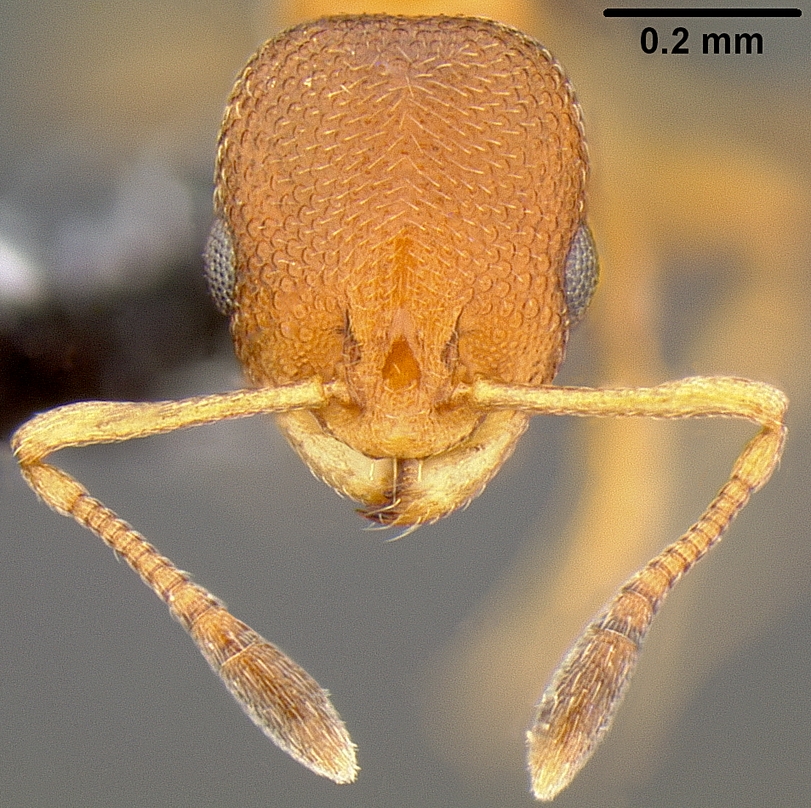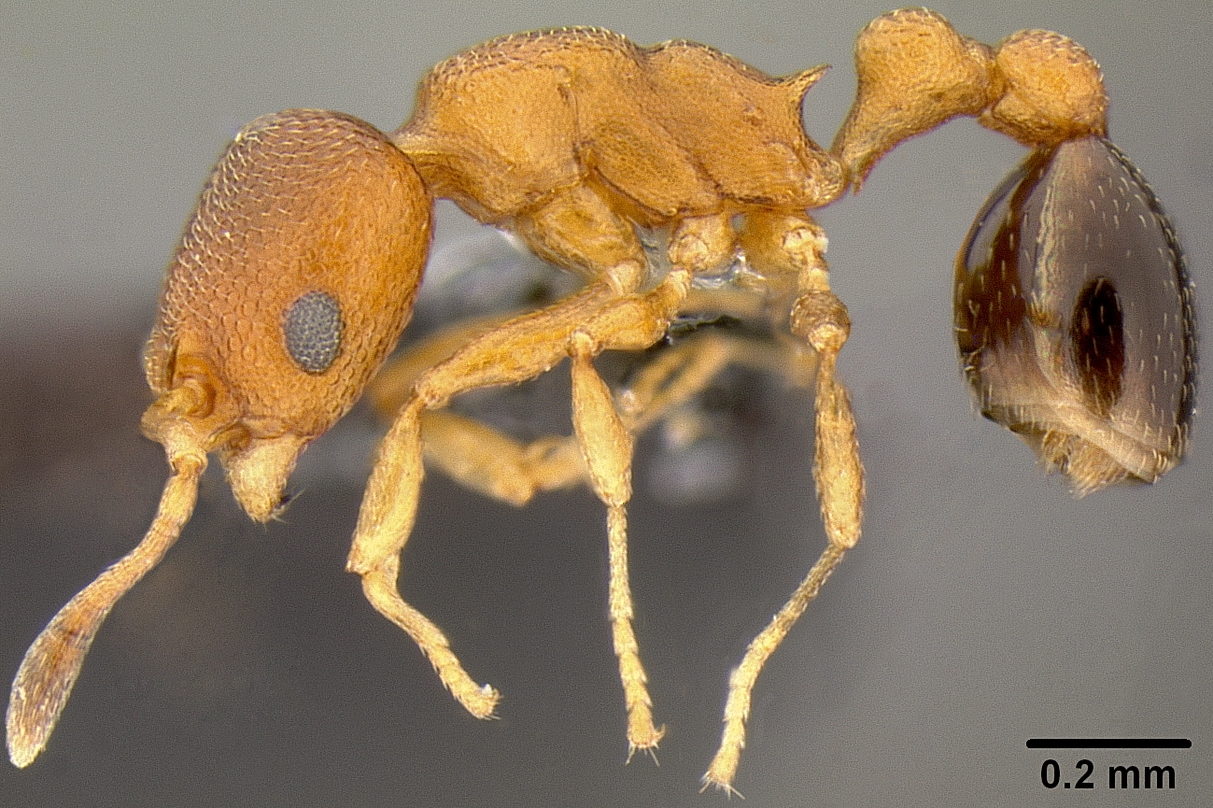Introduction
Cardiocondyla is an old world genus of omnivorous ants native to Africa and Asia. This genus includes several common tramp species that have spread globally with human commerce. Because of their small size, Cardiocondyla species are often overlooked. Colonies of most species are small (<500 workers) and are typically located in soil, especially in disturbed, open habitats near rivers, roads, forest margins, or other similar areas (Seifert 2003). However, some species also nest above ground in plant structures. Members of this genus are not generally considered to be a pest species.
Generic Overview: Cardiocondyla workers are small to medium in size (1.5 to 3.5 mm) and yellow to dark brown to bicolored yellowish-brown and dark brownish-black. The antenna is 11 or 12-merous and terminates in a 3-segmented club. The clypeus is flattened with lateral portions projecting outward. The promesonotal suture is lacking. Propodeal spines may be distinct or absent. Waist with two segments. For their small size, workers have a relatively large sting. Pilosity is sparse to entirely absent on the dorsum of body. In the southeastern United States, Temnothorax is the only genus that would be likely confused with Cardiocondyla. Temnothorax species in this region differ by having distinct pilosity present on the dorsum of the body.
Cardiocondyla obscurior is a small (~1.5 mm) yellow to yellowish-brown species with short antennal scapes and moderately sized propodeal spines, and without erect hairs on its mesosoma. The species is a well known tramp ant (Heinze et al., 2006) and has established populations throughout the world (Seifert, 2003). However, C. obscurior is not considered to be a pest species or known to negatively affect native ecosystems.
Taxonomic History (provided by Barry Bolton, 2013)
Cardiocondyla wroughtoni var. obscurior Wheeler (1929); raised to species and senior synonym of Cardiocondyla bicolor, Seifert (2003).
Original Description
Link to paper with original description by Wheeler: http://antbase.org/ants/publications/3409/3409.pdf
Identification
Workers: Monomorphic, small (TL ~1.5 mm). Head, mesosoma, and waist yellowish to yellowish-brown with gaster often darker brown; antenna yellowish, becoming infuscated apically. Head, mesosoma, and waist with strong, semi-circular rugoreticulation; gaster smooth, shining. Entire body lacking strong, erect setae; dorsum of head, mesosoma, waist, and entire gaster with slightly thickened, appressed pubescence; pubescence sparse on gaster. Head shape subrectangular. Antenna 12-merous; terminating in 3-segmented club; scape elongate, but not extending beyond posterior margin of head. Antennal scrobes lacking. Antennal insertion not surrounded by a raised sharp-edged ridge. Eyes not unusually large (distinctly less than half head length), but with numerous facets. Spines absent at posterolateral corners of head. Mandibles triangular. Mesosomal slope gradual. Metanotum with distinctly impressed groove. Pronotal spines absent. Propodeal spines relatively long (more developed than small angles). Petiole with a distinct, upright node; large subpetiolar process absent. Petiolar peduncle length less than twice its height, thickening gradually as it tapers into node. Postpetiole swollen in appearance, wider than long and much broader than petiole (in dorsal view); attached to lower surface of gaster; postpetiole as high as petiole and with a distinct ventral bulge, postpetiole in dorsal view with sharp anterolateral corners.
Cardiocondyla obscurior can be differentiated from the other four species of Cardiocondyla reported from the southeastern United States by its color, which is predominately yellowish brown except for the gaster, which is dark brown; its having a distinct metanotal groove, relatively short antennal scapes; and relatively long propodeal spines. It differs from the similar C. wroughtonii by its gaster being entirely dark and the spines tending to be somewhat shorter.
Biology and Economic Importance
According to Seifert (2003), C. obscurior is polygynous, and new colonies are often formed by nest splitting. Colony sizes are relatively small with usually less than 500 workers (Seifert, 2003). Cardiocondyla obscurior has been reported to nest in cavities of trees, bushes, in dead twigs, in coconuts, and galls (Seifert, 2003). Much has been written about the reproduction of the species, which is somewhat atypical with the ergatoid males that are produced (Heinze & Delabie, 2005; Heinze & Hölldobler, 1993).
Life Cycle: This species, similar to others in the genus, produces ergatoid males in addition to alate males.
Native Range: Asia?
Distribution
Worldwide: Canary Islands, Germany, Israel, Kenya, India, Nepal, Japan, Taiwan, Mariana Islands, Brazil, Puerto Rico, Virgin Islands (Seifert, 2003).
United States: Hawaii, Florida (Seifert, 2003).
Acknowledgments
Thanks to Ryan J. Whitehouse for help with measuring specimens, comments on descriptions, and proofreading. Funding for the ant work being done by the MEM in Alabama and Mississippi is from several sources including the National Institute of Food and Agriculture, United States Department of Agriculture, under Project No. MIS-012040, the Mississippi Agricultural and Forestry Experiment Station at Mississippi State University, with support from State Project MIS-311080, NSF Grants BSR-9024810 and DFB-9200856, the Tombigbee National Forest (U.S. Forest Service), the Noxubee Wildlife Refuge, Mississippi Natural Heritage Program Research Grant, USDA Forest Service Agreement No. 08-99-07-CCS-010, the William H. Cross Expedition Fund, and primarily by the USDA-ARS Areawide Management of Imported Fire Ant Project. Additionally, special cooperation has been provided by State Parks, National Forests, National Wildlife Refuges, the Natchez Trace Parkway, and from various private landowners in both Alabama and Mississippi.
Literature Cited
Bolton, B. 2013. Bolton World Catalog Ants. Available online: http://www.antweb.org/world.jsp. Accessed 16 April 2013.
Heinze, J., S. Cremer, N. Eckl, and A. Schrempf, 2006. Stealthy invaders: the biology of Cardiocondyla tramp ants. Insect. Soc., 53: 1-7.
Heinze, J. and J. H. C. Delabie, 2005. Population structure of the male-polymorphic ant Cardiocondyla obscurior. Stud. Neotrop. Fauna Environ., 40: 187-190.
Heinze, J. and B. Hölldobler. 1993. Fighting for a harem of queens: physiology of reproduction in Cardiocondyla male ants. Proc. Natl. Acad. Sci. U.S.A., 90: 8412-8414.
Seifert, B. 2003. The ant genus Cardiocondyla (Insecta: Hymenoptera: Formicidae) - a taxonomic revision of the C. elegans, C. bulgarica, C. batesii, C. nuda, C. shuckardi, C. stambuloffii, C. wroughtonii, C. emeryi, and C. minutior species groups. Ann. Naturhist. Mus. Wien. B. Bot. Zool. 104(B): 203-338.
Wheeler, W. M. 1929. Ants collected by Professor F. Silvestri in Formosa, the Malay Peninsula and the Philippines. Bollettino del Laboratorio di Zoologia Generale e Agraria della Reale Scuola Superiore d'Agricoltura. Portici 24: 27-64.
Links
AntWeb
AntCat
AntWiki
Ants of Costa Rica: Cardiocondyla obscurior Wheeler 1929
Identification Guide to Invasive Ants of the Pacific Islands: Cardiocondyla obscurior |




